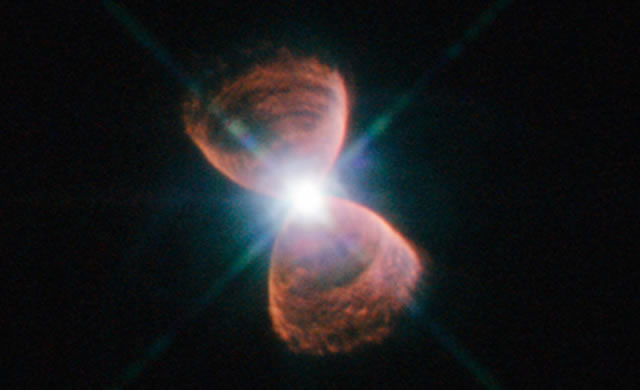
Hubble 12 – Credit: ESA/NASA
Alcuni astronomi hanno usato l’NTT (New Technology Telescope) dell’ESO e il telescopio spaziale Hubble della NASA/ESA per esplorare più di 100 nebulose planetarie nel ringonfiamento galattico. Hanno trovato che i membri di questa famiglia cosmica a forma di farfalla tendono a essere misteriosamente allineati – un risultato sorprendente date le loro diverse storie e le proprietà differenti.
Negli stadi finali della vita di una stella come il Sole gli strati esterni vengono espulsi nello spazio circostante, formando oggetti noti come nebulose planetarie, con un ampia casistica di forme suggestive. Un particolare tipo di queste nebulose, note come nebulose planetarie bipolari, creano strutture spettrali a forma di clessidra o di farfalla intorno alla stella madre. Le nebulose si formano in luoghi diversi e hanno diverse caratteristiche. E nè le singole nebulose nè le stelle che le hanno formate di solito interagiscono con altre nebulose planetarie. In realtà un nuovo studio degli astronomi dell’Università di Manchester, Regno Unito, mostra sorprendenti analogie per alcune di esse: molte sono allineate nello stesso modo in cielo. “Questo è una scoperta davvero sorprendente e, se confermata, molto importante”, speiga Bryan Rees dell’Università di Manchester, uno dei due autori dell’articolo. “Molte di queste spettrali farfalle sembrano avere l’asse maggiore allineato lungo il piano della Galassia. Usando immagini di Hubble e dell’NTT possiamo riprendere questi oggetti molto bene e studiarli così in gran dettaglio”. Gli astronomi hanno osservato 130 nebulose planetarie nel rigonfiamento centrale della Via Lattea, ne hanno identificato tre diversi tipi e guardato con attenzione alle loro caratteristiche e al loro aspetto. “Mentre per due di queste popolazioni l’orientamento in cielo era assolutamente casuale, come previsto, abbiamo trovato per la terza – le nebulose bipolari – una sorprendente tendenza ad un allineamento particolare”, dice il secondo autore dell’articolo Albert Zijlstra, anch’egli dell’Università di Manchester. “Se l’allineamento in sè è una sorpresa, osservarlo nell’affollata regione centrale della Galassia è ancora più inatteso”.
Fonte/Leggi tutto → ESO.org
Astronomers have used ESO’s New Technology Telescope and the NASA/ESA Hubble Space Telescope to explore more than 100 planetary nebulae in the central bulge of our galaxy. They have found that butterfly-shaped members of this cosmic family tend to be mysteriously aligned — a surprising result given their different histories and varied properties.
The final stages of life for a star like our Sun result in the star blowing its outer layers out into the surrounding space, forming objects known as planetary nebulae in a wide range of beautiful and striking shapes. One type of such nebulae, known as bipolar planetary nebulae, create ghostly hourglass or butterfly shapes around their parent stars. All these nebulae formed in different places and have different characteristics. And neither the individual nebulae, nor the stars that formed them, would have interacted with other planetary nebulae. However, a new study by astronomers from the University of Manchester, UK, now shows surprising similarities between some of these nebulae: many of them line up in the sky in the same way. “This really is a surprising find and, if it holds true, a very important one,” explains Bryan Rees of the University of Manchester, one of the paper’s two authors. “Many of these ghostly butterflies appear to have their long axes aligned along the plane of our galaxy. By using images from both Hubble and the NTT we could get a really good view of these objects, so we could study them in great detail.” The astronomers looked at 130 planetary nebulae in the Milky Way’s central bulge. They identified three different types, and peered closely at their characteristics and appearance. “While two of these populations were completely randomly aligned in the sky, as expected, we found that the third — the bipolar nebulae — showed a surprising preference for a particular alignment,” says the paper’s second author Albert Zijlstra, also of the University of Manchester. “While any alignment at all is a surprise, to have it in the crowded central region of the galaxy is even more unexpected.”
Source/Continue reading → ESO.org





















